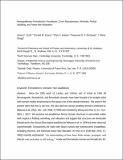Nonequilibrium ferroelectric-ferroelastic 10-nm nanodomains : wrinkles, period-doubling, and power-law relaxation
Abstract
Since the 1935 work of Landau and Lifshitz and of Kittel in 1946 all ferromagnetic, ferroelectric, and ferroelastic domains have been thought to be straight-sided with domain widths proportional to the square root of the sample thickness. We show in the present work that this is not true. We also discover period doubling domains predicted by Metaxas et al. (Phys. Rev. Lett. 2008, 217208) and modeled by Wang and Zhao Q. (Sci. Rpts. 2015, 5, 8887). We examine non-equilibrium ferroic domain structures in perovskite oxides with respect to folding, wrinkling, and relaxation and suggest that structures are kinetically limited and in the viscous flow regime predicted by Metaxas et al. in 2008 but never observed experimentally. Comparisons are made with liquid crystals and hydrodynamic instabilities, including chevrons, and fractional power-law relaxation. As Shin et al. [Soft Mat. 2016, 12, 3502] recently emphasized: “An understanding of how these folds initiate, propagate, and interact with each other is still lacking.” Inside each ferroelastic domain are ferroelectric 90-degree nano-domains with 10-nm widths and periodicity in agreement with the 10-nm theoretical minima predicted by Feigl et al. (Nat. Commun. 2014, 5, 4677). Evidence is presented for domain-width period doubling, which is common in polymer films but unknown in ferroic domains. A discussion of the folding-to-period doubling phase transition model of Wang and Zhao is included.
Citation
Scott , J F , Evans , D , Katiyar , R , McQuaid , R & Marty Gregg , J 2017 , ' Nonequilibrium ferroelectric-ferroelastic 10-nm nanodomains : wrinkles, period-doubling, and power-law relaxation ' , Journal of Physics: Condensed Matter , vol. 29 , no. 30 , 304001 . https://doi.org/10.1088/1361-648X/aa77da
Publication
Journal of Physics: Condensed Matter
Status
Peer reviewed
ISSN
0953-8984Type
Journal article
Collections
Items in the St Andrews Research Repository are protected by copyright, with all rights reserved, unless otherwise indicated.

